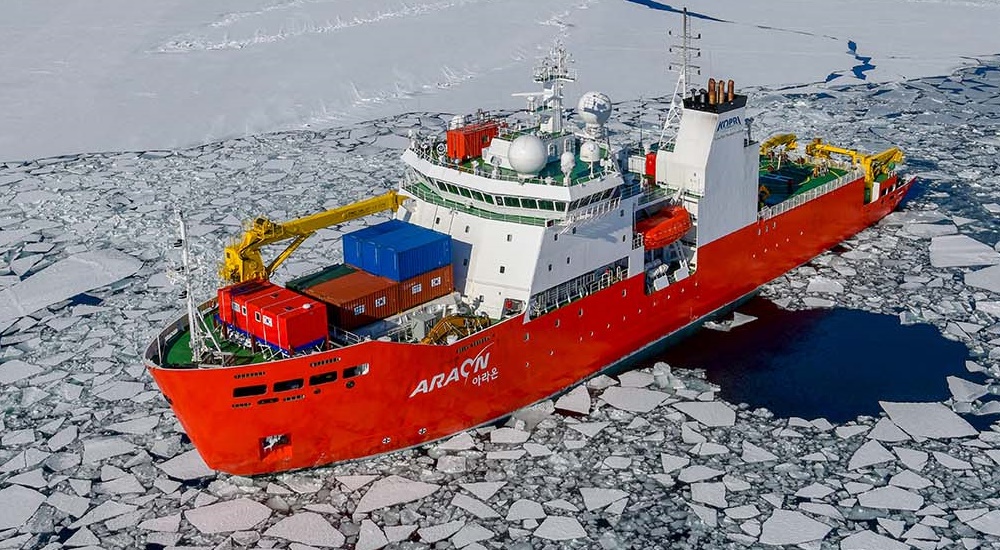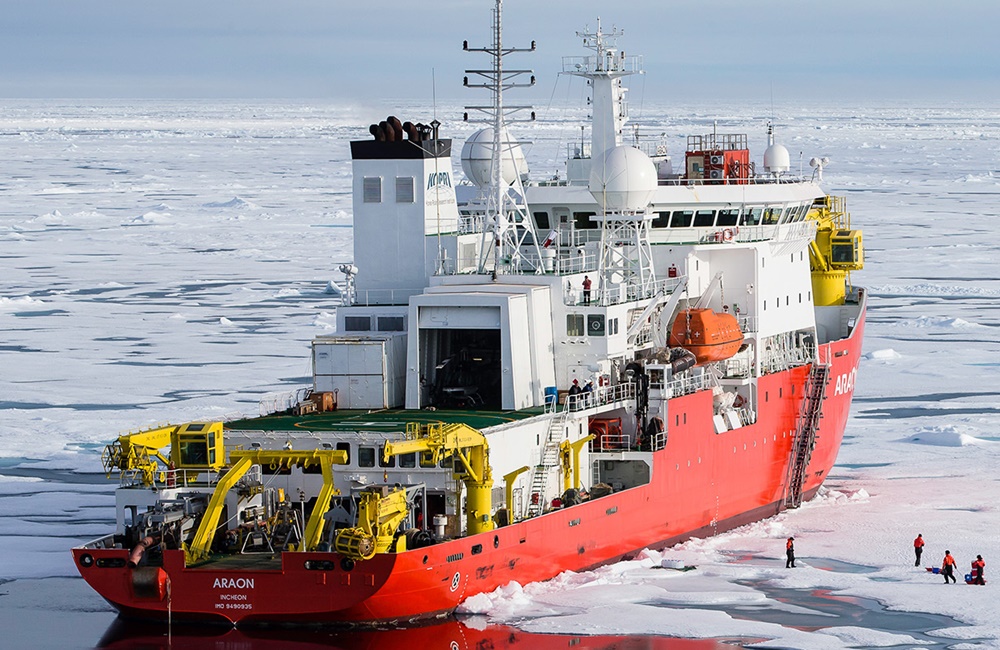Araon icebreaker
Araon icebreaker current position
The current location of Araon icebreaker is in South Pacific Ocean cruising at speed of 13.2 kn (24 km/h | 15 mph) en route to LYTTELTON, NZ. The AIS position was last reported 22 minutes ago.
Current PositionSpecifications of Araon icebreaker
| Year of build | 2009 / Age: 16 |
| Flag state | Korea |
| Builder | Hanjin Heavy Industries/Yeongdo Shipyard (Busan, Korea) |
| Class | PC10 icebreaking research vessel |
| Ferry route / homeports | Incheon |
| Building cost | KRW 108 billion (USD 94 million / EUR 65,5 million) |
| Engines (power) | Wartsila ( MW / 0 hp) |
| Propulsion power | 10 MW / 13410 hp |
| Speed | 16 kn / 30 km/h / 18 mph |
| Length (LOA) | 111 m / 364 ft |
| Beam (width) | 19 m / 62 ft |
| Gross Tonnage | 6950 gt |
| Passengers | 60 |
| Crew | 25 |
| Decks | 6 |
| Decks with cabins | 3 |
| Owner | Ministry of Land, Infrastructure and Transport (South Korea) |
| Operator | Korea Polar Research Institute (KOPRI) |
Araon icebreaker Review
Review of Araon icebreaker
The 2009-built RV Araon is an icebreaking research vessel (RV) and South Korea's only icebreaker. The ship was constructed by Hanjin Heavy Industries at the Yeongdo Shipyard in Busan.
The vessel (IMO number 9490935) is Korea-flagged (MMSI 441619000) and registered/homeported in Incheon.
The name "Araon" combines two Korean words—"ara" (sea) and "on" (all).
History - construction and ownership
The shipbuilder, Hanjin Heavy Industry Co Ltd, is a shipbuilding company founded in 1937 and headquartered in Busan. The company specializes in gas platforms and gas carriers (LNG and LPG), as well as the construction of various marine vessels, including cable layers, container ships, icebreakers, hovercraft, and naval vessels (warships and patrol boats). Hanjin Heavy Industry is a subsidiary of the Seoul-based Hanjin Group, one of South Korea's largest corporations.

South Korea's icebreaker project began in 2003 with a feasibility study, followed by design development in 2004 and the preparation of construction documents in 2005. Construction started in May 2006. The vessel was launched (floated out from drydock) on June 11, 2009, delivered in September, and commissioned in November 2009 by MOLIT (South Korea's Ministry of Land, Infrastructure and Transport).
RV Araon's maiden voyage began on December 18, 2009, from Incheon. It included a bunkering stop in New Zealand (Port Lyttelton/Christchurch) on January 8, 2010, and arrival in Antarctica on January 12. The vessel conducted successful 10-day sea trials in ice conditions in the Ross Sea in January 2010. During this inaugural voyage, the location for Korea's second Antarctic base, Jang Bogo Station, was selected by Araon.
The Araon icebreaker is operated by the Korea Polar Research Institute (KOPRI) and is used for polar research and logistics, transporting supplies to South Korea's two Antarctic bases—King Sejong Station (established in 1988 at King George Island's Barton Peninsula) and Jang Bogo Station (opened in 2014 at Terra Nova Bay, Antarctic Peninsula).
- King Sejong Station includes 11 buildings and 2 observatories, accommodating up to 90 people (scientists during the summer season). During winter, the base is maintained by 17 personnel (engineers and scientists). It is usually supplied by the Korean ship RV Onnuri (1991-built, IMO 9011583) and also by aircraft from two Antarctic stations on King George Island—Argentina's Carlini Base (at Potter Cove) and Chile's Eduardo Frei Montalva Base (at Fildes Peninsula).
- Jang Bogo Station is located on mainland Antarctica and was inaugurated in February 2014. The base consists of two buildings: one large, star-shaped facility (4000 m2 / 43,055 ft2, with three wings) and a smaller, rectangular warehouse. It accommodates up to 60 people and is maintained by 15 personnel during the winter. Located about 9 km (5.5 mi) south-southwest of Jang Bogo is Italy's Zucchelli Station (at Tethys Bay). Construction materials for Jang Bogo were shipped from Busan to Lyttelton, NZ, and then transported to Antarctica by RV Araon.
RV Araon vessel details and technology
The ship is powered by two Wartsila marine diesel engines (5 MW each, total output 10 MW). The propulsion system is diesel-electric, where electricity generated by the engines powers the propulsion motors. Four Wartsila thrusters assist in navigation—two aft (360-degree azimuthing propellers mounted outside the hull) and two bow thrusters (tunnel-type, in-hull mounted). The aft thrusters are integrated into a self-healing computing system that allows the vessel to free itself (by rocking side to side) if stuck in ice. The sharply sloped bow and an ice knife beneath the hull help the vessel rise above and crush the ice with its weight.
The icebreaker has a maximum speed of 16 knots (30 kph / 18 mph) in open waters, a service speed of 12 knots (22 kph / 14 mph), and an icebreaking speed of 3 knots (6 kph / 3.5 mph) through ice up to 1 meter (3 ft) thick. The hull is constructed using 4-cm (1.6-in) thick steel plates.
The ship’s storage and fuel capacities allow for a range of 20,000 nautical miles (37,000 km / 23,000 mi) and up to 70 days of autonomous operation. It is capable of functioning in air temperatures from -30°C (-58°F) to +50°C (122°F). The design supports safe navigation in "Sea State 6" conditions (wave heights 4-6 m / 13-20 ft) and survival in "Sea State 8" conditions (wave heights 9-14 m / 30-46 ft).
Onboard equipment includes one cargo barge (10 m / 33 ft), one workboat (7 m / 23 ft), two lifeboats (port and starboard), a mini-submarine, and one helicopter (stored on the helideck or in the adjacent hangar). The helideck is located at the stern and is adjacent to the working deck, which is equipped with a heavy-duty crane.

The ship has cargo space for 46 TEU containers—31 on the open-air work deck and 15 in the cargo hold. Araon's maximum passenger capacity is 60 (scientists and mission personnel), in addition to a 25-member crew (Captain, officers, and staff). Most cabins are double-occupancy and come equipped with bunk beds, LCD TVs, en suite bathrooms (toilet, washbasin, shower), and mini-refrigerators. Of the six decks onboard, three contain staterooms.
The vessel's scientific facilities include 10 research laboratories and multiple networked spaces, such as wet and dry labs, a chemical lab, biology lab, computer room, LAN office, data-processing and measurement rooms. Research instruments include a CTD/Sonde (for seawater conductivity, temperature, and pressure), thermosalinograph (for measuring surface temperature and conductivity), acoustic instruments (multibeam echo sounders, ADCPs, synchronizer), geophysical instruments (multichannel seismic system, dynamic gravity system, sub-bottom profiler, Thermo PDR/aerosol monitor), biological tools (RMT, Bongo/Plankton Net System, underwater 3D sensor, MOCNESS for synchronous sampling of zooplankton and sea creatures), as well as observation and monitoring systems (weather station, radio and satellite antennas, seawater analyzer).

